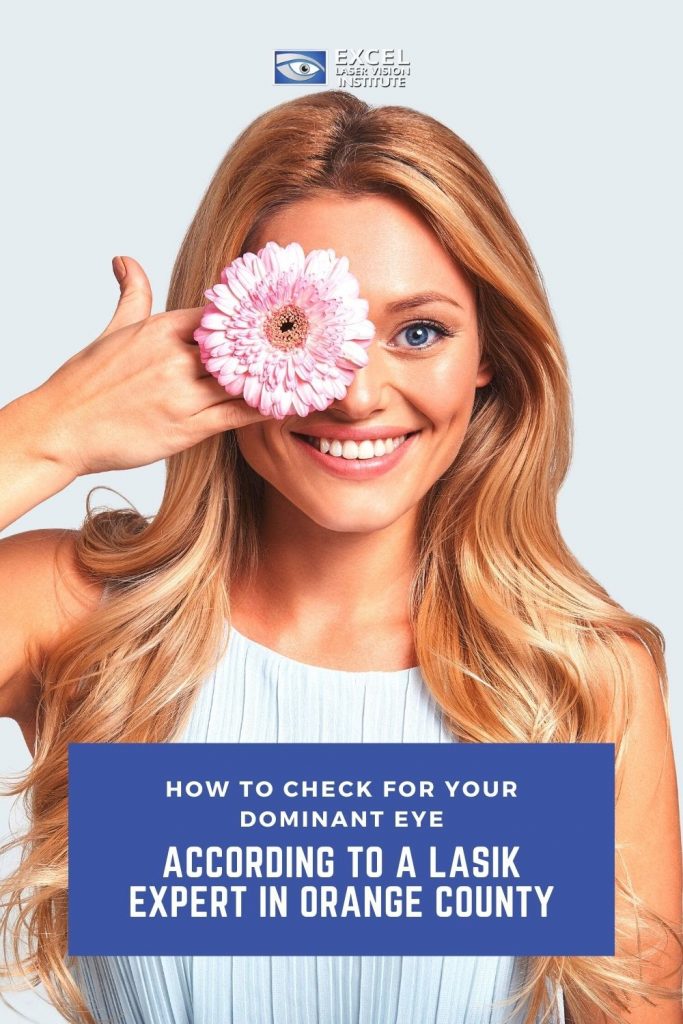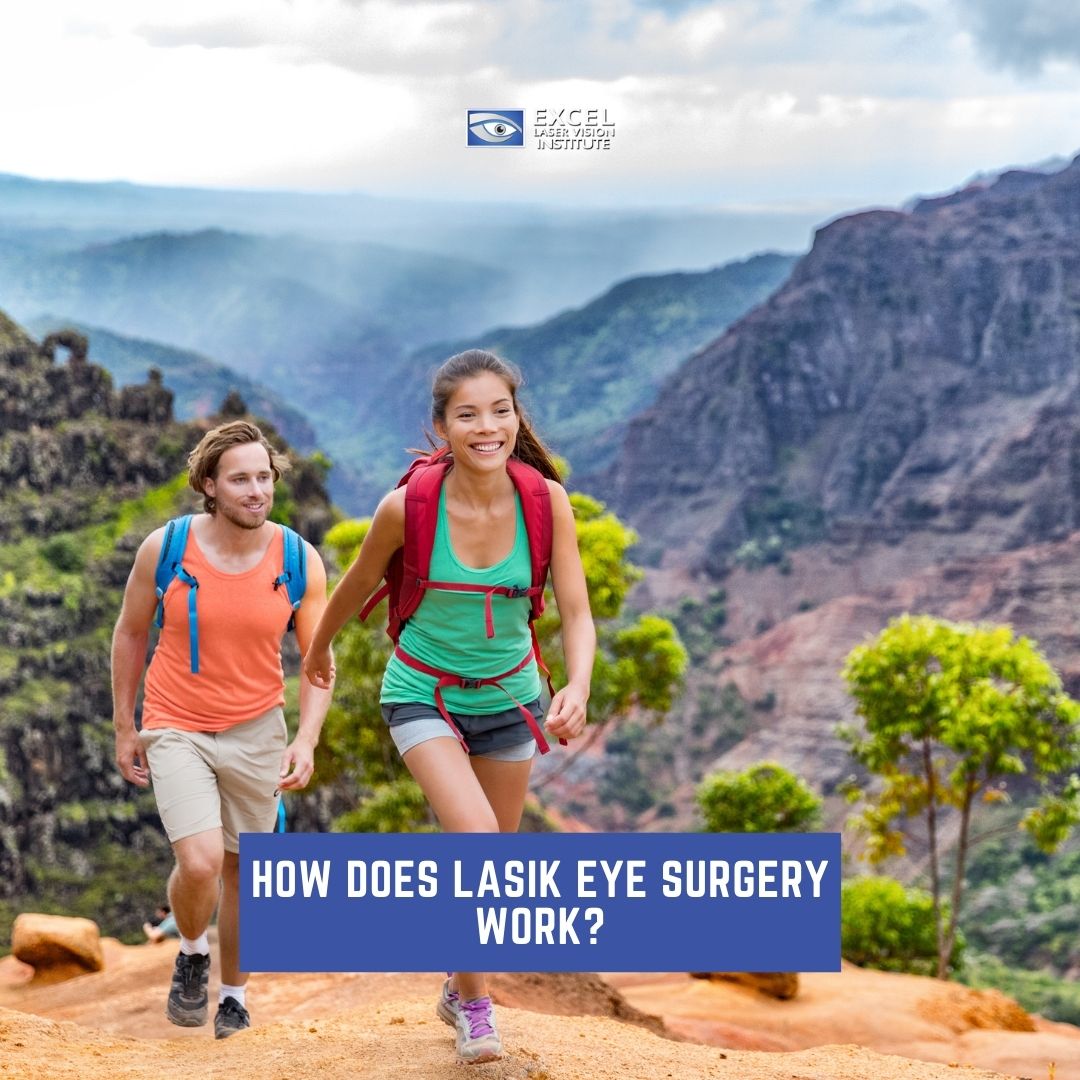
How Does LASIK Eye Surgery Work?
LASIK eye surgery is one of the most requested laser refractive surgeries in Orange County and is used to correct vision issues, such as nearsightedness, farsightedness, and astigmatism.
If you are thinking about getting the best laser eye surgery, you may be curious about what to expect from the procedure. Below, the LASIK eye surgery professionals explain how LASIK surgery works and what patients can expect from their experience.
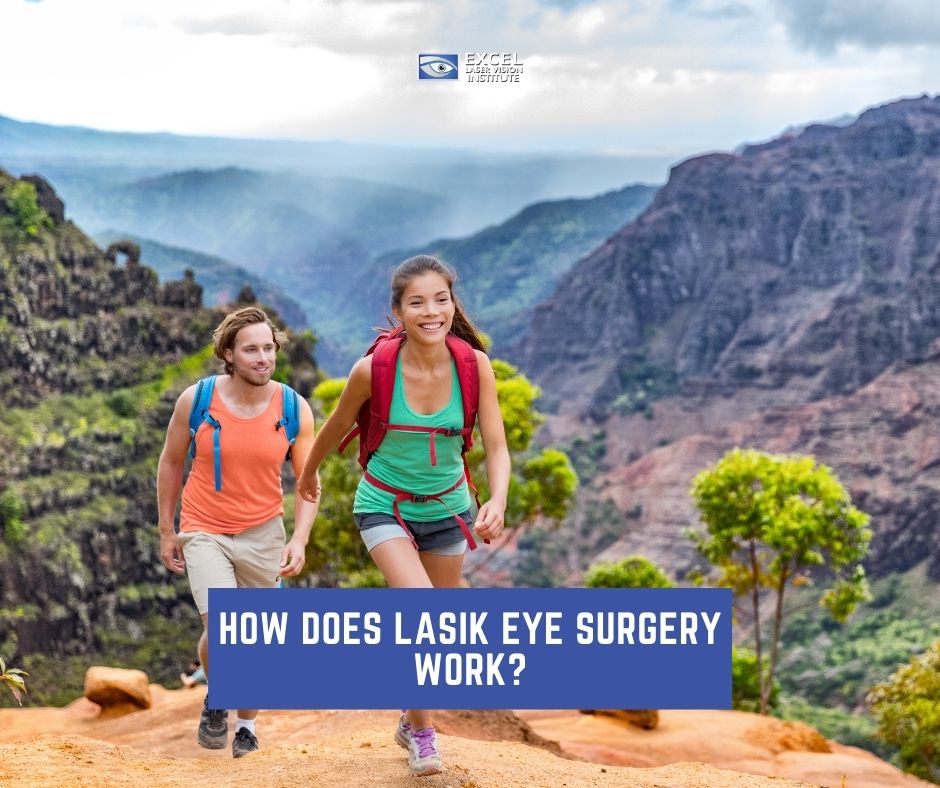
How LASIK Eye Surgery Works
Vision problems usually occur because of an error in how our eyes refract light. During the vision process, light rays go through various structures of the eye. This consists of the cornea, which is the transparent, dome-shaped structure covering the front of the eye, and then the crystalline lens, which is the natural lens that gets light rays refracted by the cornea and focuses light into an image on the retina that lines the back of the eye. Still, if the light is bent improperly, laser eye doctors say that it prevents an exact image from forming, resulting in blurred or weakened vision.
As LASIK professionals emphasize, eyeglasses and contact lenses are just a temporary fix to improve vision. It allows the eye to focus light in the correct spot on the retina, which produces the clearest image whenever possible. Nevertheless, LASIK eye surgery is devised to offer a long-term solution by reshaping the cornea itself to repair the refraction. LASIK is an abbreviation for Laser in Situ Keratomileusis, and as its name implies, it uses a laser to change the cornea’s shape.
During the operation, the surgeon will usually use an instrument known as a microkeratome to make a flap in the cornea, which can be pulled back to reveal the underlying corneal tissue. If that turns you off from doing the procedure, there are also bladeless forms of LASIK that use a high-energy laser to produce the same flap. At that point, the surgeon uses an excimer laser to reshape the cornea to correct the patient’s vision.
However, in the back of your mind, you may be wondering how the surgeon knows the correct shape to reshape the cornea into. Before the procedure, the surgeon creates a pre-specified cornea pattern. This is carried out using advanced diagnostic technology and numerous extensive pre-operative tests to measure the thickness and shape of the cornea. This provides a three-dimensional map of the cornea’s structures.
This helps the surgeon to determine beforehand what shape the cornea should be to correct the patient’s vision issues.
What to Expect Before, During, And After LASIK
You don’t have to worry about experiencing a lot of downtime after your LASIK procedure. It provides the quickest and easiest recovery periods, especially when you compare it to other types of procedures. The majority of people return to their normal routines within 24 hours.
Nonetheless, you have to keep in mind that LASIK is a process. To ensure that the best results are possible, LASIK patients can expect to go through the following experiences that lead up to and after their surgery.
BEFORE THE PROCEDURE
If you are interested in a LASIK procedure, you have to attend a pre-operative consultation to find out of you are eligible for LASIK or any other vision correction procedure. During your consultation, an eye doctor takes a look at your vision and eye health. An experienced optometric physician can explain the procedures and answer any questions or address any concerns you may have.
The first consultation usually involves several painless tests to determine whether or not you are a suitable candidate. Depending on your prescription, the patient’s pupils may require dilation.
DURING THE PROCEDURE
On the day of the surgery, your doctor will verify your eye prescription again, and your pupils are measured to ascertain the best results. The surgeon will also let you know what to expect during the procedure, review post-operative care instructions, and fill out the remaining paperwork. If you wear contact lenses, which can change the cornea’s shape, you have probably been already told to stop wearing them for a specific amount of time before the surgery.
Generally speaking, you will most likely be at the clinic for about 3 to 4 hours on the day of the procedure. LASIK eye surgery only lasts about 15 minutes, and the laser is used for less than 10 seconds on each eye. You will be asked to take a seat and given numbing eye drops. The surgeon uses an instrument to keep your eyes open, a suction ring is placed over your eye before they cut the corneal flap. The patient may feel pressure or dimness in their vision.
When the flap is created, the surgeon folds it back to get to the area of the cornea that needs reshaping. Using a laser, the surgeon starts the reshaping process. The patient will be asked to focus on the point of light, which keeps their eye fixed while the laser reshapes the cornea. Each laser pulse removes a part of the corneal tissue. Then the surgeon lays the flap back into place when the corneal shape is acceptable; the flap heals on its own.
AFTER THE PROCEDURE
Normally, patients experience some form of irritation after the procedure. The eyes may feel itchy, burning, or watery. Also, a person’s vision will probably be blurry. Overall, LASIK eye surgery is a painless procedure.
LASIK eye surgery is one of the safest and most convenient elective surgeries around. It offers a long-term solution to vision issues and can transform the quality of life for so many people. If you want to learn more about LASIK eye surgery and other correction options, book a free consultation at any of Excel Laser Vision Institute’s clinics in Orange County or Los Angeles or call (888) 957-3255, or visit our website to get more details: https://www.exceleye.com/.
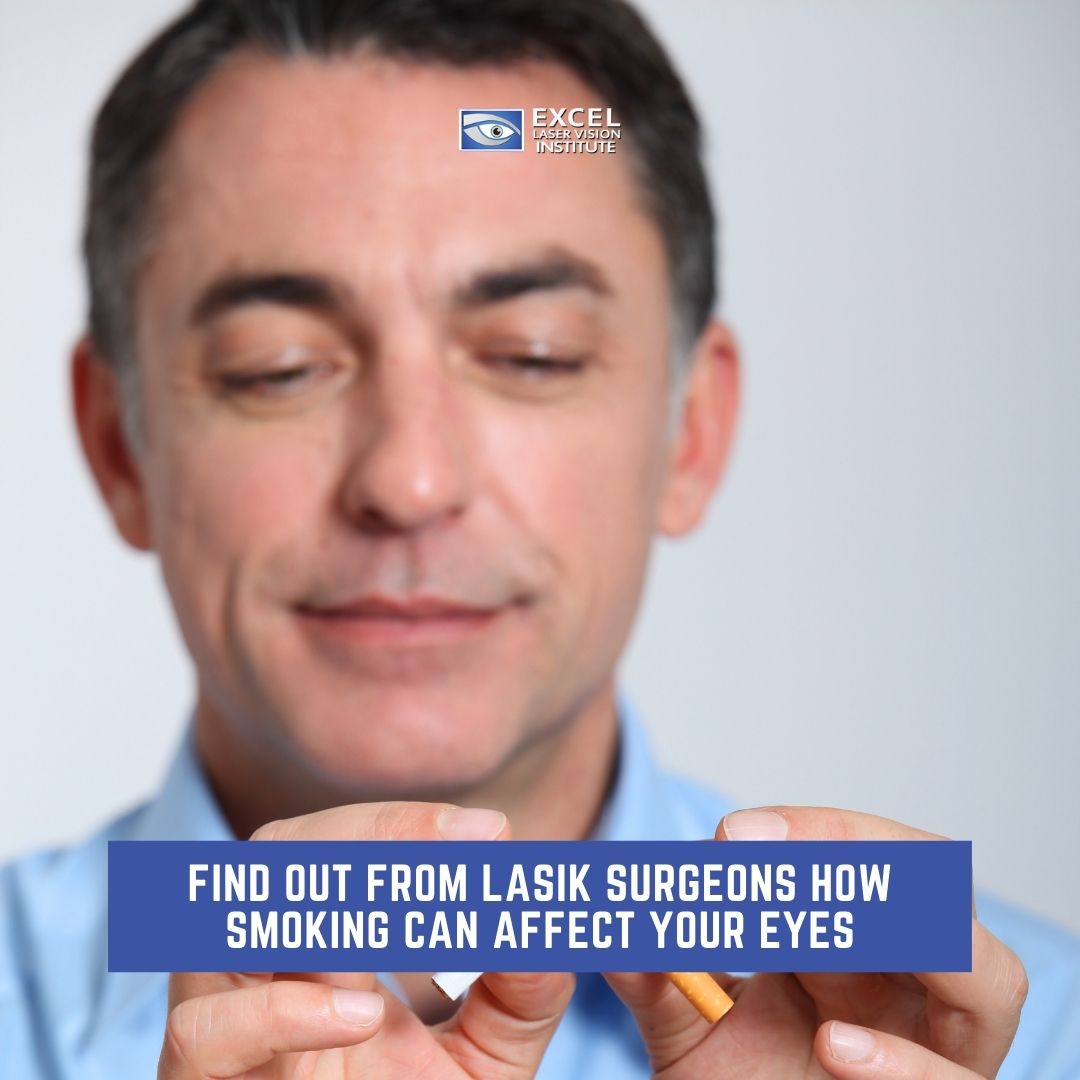
Find Out From LASIK Surgeons How Smoking Can Affect Your Eyes
Any medical professional will tell you that smoking is very harmful to your health. As a matter of fact, LASIK doctors and ophthalmologists will go into a huge rant on how smoking can make a huge negative impact on your eyes.
The best LASIK surgeons in Los Angeles, like Doctor Moosa, let us know that cigarettes contain about 4,000 chemicals. The reality is that some of these poisonous chemicals can result in long-term cellular damage in the eye, increasing the risk of corneal infections and prolonging healing time.
The LASIK surgeons take a look at five different diseases that have a higher possibility of developing in smokers. Some of these diseases are so dangerous that they could result in permanent blindness.
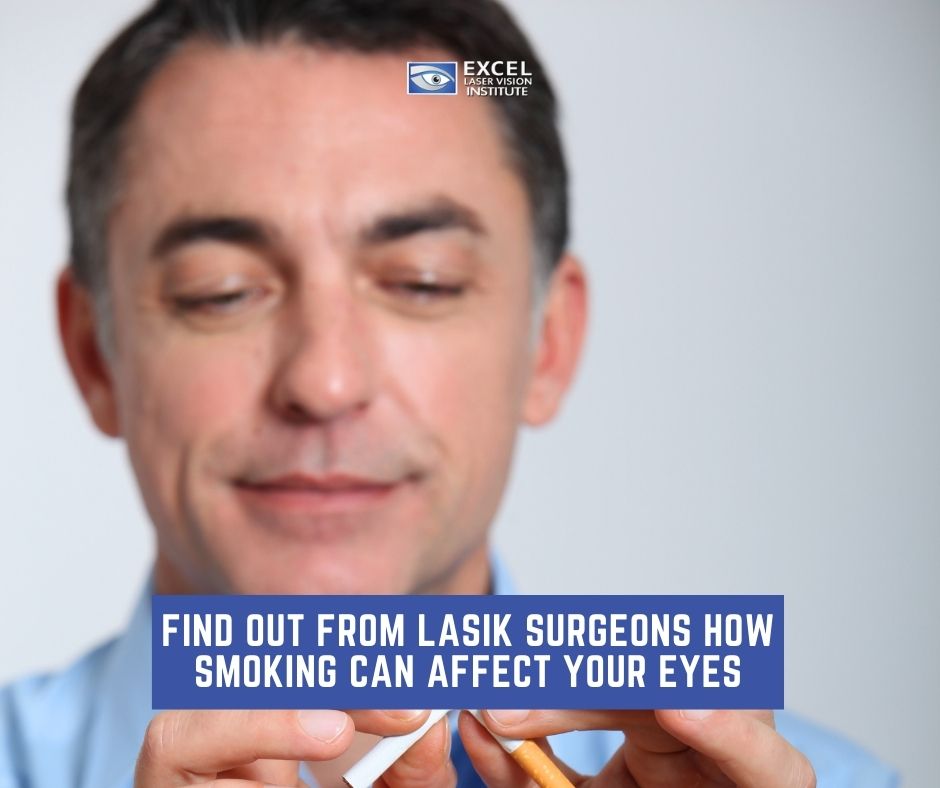
Five Ocular Diseases That Smokers Might Get
Cataracts
The LASIK eye specialists make it clear that daily smoking can put you at increased risk for cataracts. Cataracts, which are the clouding of the eye’s natural lens, occur to almost everyone when they reach the age of 80.
When cataracts begin to develop, they can result in blurry vision and, with some extreme case scenarios – complete blindness. A recent study revealed that there is a strong connection between smoking and the increased risk of age-related cataracts. Not surprisingly, those who smoke cigarettes regularly are most likely to get cataracts at an earlier age than non-smokers.
Graves’ Ophthalmopathy
Not only does smoking tobacco harm your lungs, but it also increases your risk of developing eye-related problems caused by thyroid disease. Graves’ ophthalmopathy affects the immune system, in particular, the thyroid.
As a result of this condition, the tissue and muscles around the eyes are damaged. Complications start because of this disorder, and a person can suffer from double vision, eye-bulging, eye inflammation, eye pain, and vision loss.
Uveitis
Doctor Moosa, one of the leading LASIK surgeons in Los Angeles points out that exposure to toxic chemicals, especially those found in cigarettes, causes uveitis – an inflammation of the eye. Also, it can affect the iris, which is the colored part of the eye. In general, smoking can put you at a higher risk of acquiring this disorder, leading to serious complications such as glaucoma and vision loss.
Age-Related Macular Degeneration (AMD)
If you are a daily cigarette smoker, you are three times more likely to get a chronic disease known as age-related macular degeneration. Age-related macular degeneration, otherwise known as AMD, causes the macula, the oval-shaped pigmented area near the retina’s center, to deteriorate and lead to vision loss. The macula is the part of the eye that provides acute vision. If you have AMD, your central vision will be impaired. As a result of this, you probably will not be able to participate in everyday tasks that involve your eyesight, such as reading, writing, or driving.
Diabetic Retinopathy
You have a higher risk of getting diabetes if you are frequently exposed to tobacco smoke. Diabetes can cause an eye disorder known as diabetic retinopathy, which occurs when the eye’s blood vessels are damaged. As a result, there are many vision complications, such as blindness.
With all this information around, it is vital that you are aware of the negative impact cigarettes can have on your overall health. It is advisable that if you are currently a regular smoker, that you should consider kicking this bad and harmful habit. Quitting smoking is the first step forward in lowering your chances of developing harmful ocular diseases and enhancing your health.
Dry Eyes
When a person experiences dry eyes, they usually don’t have enough tears on the eye’s surface, which are required to preserve eye lubrication and keep them healthy. Those who suffer from dry eyes can experience eye redness, itchiness, a sensation that something foreign is in their eye, and watery eyes.
Tobacco smoke is a well-known eye irritant and aggravates dry eyes even when the smoke is derived from second-hand smokers, and it is especially harmful to contact lens wearers. People who smoke have twice the likelihood of developing dry eyes.
Smoking And Infant Eye Disease
Women who smoke while pregnant can transmit dangerous toxins to the placenta, harming the unborn child. Smoking during pregnancy can increase the possibility of any fetal and infant eye disorders and other serious health problems.
These eye issues include strabismus (crossed eyes) and underdevelopment of the optic nerve, which is a leading cause of blindness in children.
Plus, women who smoke during pregnancy are more likely to give birth prematurely. Most babies born prematurely are at higher risk of eye issues than full-term babies.
Premature babies usually have vision problems that include retinopathy of prematurity, a potentially blinding disease.
If you are a smoker, especially one who has been smoking for many years, or is experiencing some unusual vision loss, or is concerned about your eye health, then it is a good idea to talk to an eye care professional at Excel Laser Vision Institute, a reputable LASIK clinic in Los Angeles.
Laser eye surgery can treat some eye diseases, such as cataracts that cigarette smoking can cause at an earlier age. LASIK professionals will conduct a thorough evaluation of your eye health and condition before deciding if you are eligible for LASIK eye surgery or a similar procedure.
If you are serious about quitting smoking and want to check or improve your eyesight, contact Excel Laser Vision Institute at (888) 957-3255. Our team of staff is highly trained and experienced. Our leading eye surgeon, Dr. Moosa, a well-esteemed LASIK surgeon in Los Angeles, has a Harvard education and a wealth of experience working with different prescription levels. Dr. Moosa has helped many professionals achieve their vision goals, from athletes to models to military personnel. Visit our website to learn more: https://www.exceleye.com/.
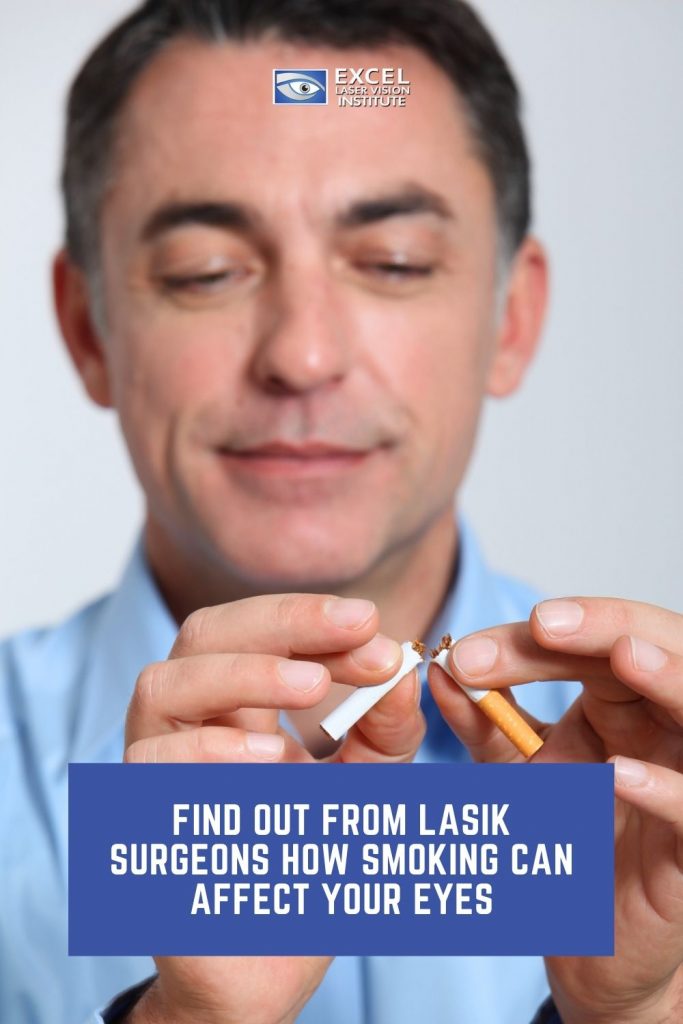
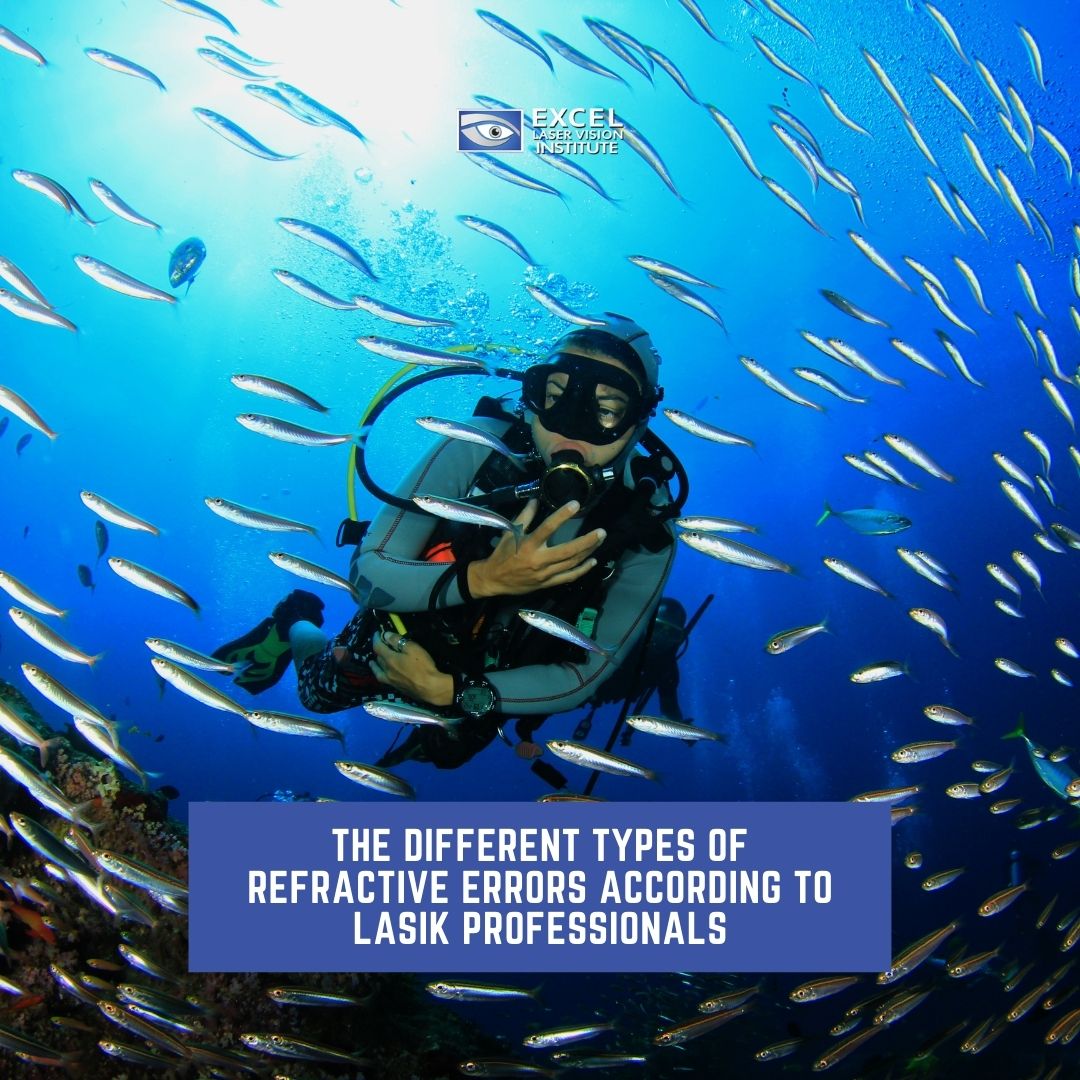
The Different Types Of Refractive Errors According To LASIK Professionals
LASIK eye doctors in Orange County can recognize a refractive error, which is an alteration in the shape of the eye that leads vision to become blurred. The LASIK surgeon educates that refraction, or the bending of light, is what helps all of us to see.
When you look at an object, the light rays it reflects are refracted through the clear, outermost layer of the eye – known as the cornea – onto an inner lens. Then the lens focuses light onto the retina, a layer of light-sensitive tissue located at the back of the eye.

The retina changes patterns of light into electrical signals and transmits these signals to the brain through the optic nerve. In the brain, these signals are identified as images of the objects you notice all around you.
As Doctor Moosa, a LASIK eye surgery professional in Orange County says, a refractive error happens when the eye cannot bend and focus light correctly onto the retina. Vision may become blurry, hazy, or doubled, which results in a person having to squint and strain their eyes. Other usual symptoms include headaches because of the eyestrain or difficulties reading.
When it comes to children, the ophthalmologists confirm that a refractive error can affect a child’s reading level and have a negative impact on their overall learning. It can even result in permanent and uncorrectable degradation in vision, referred to as refractive amblyopia. When adults have a refractive error, they usually experience blurry vision, which can be very uncomfortable, inconvenient, and even unsafe, particularly when they have to drive or operate heavy machinery.
Ophthalmologists and LASIK eye doctors At Excel Laser Vision Institute can quickly ascertain the type of refractive error that is causing you vision loss.
Myopia
Myopia, also known as nearsightedness, is when a person can’t see distant objects clearly. When you have myopia, objects at a distance look blurred, making it a challenge to read a school blackboard or street signs. Myopia happens when refracted light is focused in front of the retina rather than onto the retina. This may happen if the eyeball has an extended shape or if the cornea has too much curvature.
Myopia is usually first discovered in childhood and is common to run in families. Most of the time, myopia worsens over the years throughout an individual’s school-age and adolescent years. Eventually, myopia balances itself out when the person is in their 20s.
Many people with myopia, particularly those younger than age 35, can see objects up close without any issues. Those who are older than the age of 35 may experience presbyopia too, which makes it challenging to see objects up close.
Hyperopia
Hyperopia, or farsightedness, happens when distant objects are easier to see clearly than nearby objects. If hyperopia is considerable, the person’s vision may be blurry at any distance. Hyperopia happens when light is refracted behind the retina rather than onto the retina. This may happen if the eyeball is too short or if there is too little curvature in the cornea.
Hyperopia can happen at any age. Sometimes children can experience slight hyperopia that corrects itself by the time they are adolescents.
Astigmatism
Astigmatism is blurred vision that is caused by an unusually shaped cornea. When a person has astigmatism, the cornea is shaped very similar to a football or an egg instead of a sphere.
When light hits an eye with astigmatism, it gets distorted and refracted to many focus points within the eye rather than on one focus point on the retina. Normally, people with astigmatism have issues seeing objects close up and far away.
Astigmatism can be categorized into two types: regular, in which the eyeball is not spherical but is symmetrical, and then there is irregular, which means the eyeball is not spherical and not symmetrical.
Regular astigmatism is a lot more usual than irregular astigmatism.
Sometimes people are born with astigmatism, and children are usually diagnosed with this refractive error. It usually affects both eyes. There are instances when only one eye is affected – such as an eye injury such as a cut or puncture that results in a scar on the cornea. Also, astigmatism may be caused by a condition known as keratoconus, which is when the cornea thins and starts to bulge outward.
Presbyopia
As you get older, you may realize that your ability to focus up close, especially as you read, gets worse. Presbyopia occurs to many people at some point after the age of 40 since the eyes’ lenses, which focus light, slowly lose their ability to change their shape to let you focus on nearby objects.
Presbyopia and macular degeneration are not the same. Macular degeneration occurs when the macula, located near the center of the retina, is damaged. It usually happens in individuals who are older than 70 and causes blurriness in the central field of vision when you look at objects that are close up or far away.
On the other hand, presbyopia only changes the lens of the eye and causes the whole field of vision to blur when you try to focus on something up close.
Only a thorough examination by an ophthalmologist or optometrist can identify common age-related changes in the eye, such as presbyopia and changes in vision-related to macular degeneration.
If you have any other questions or concerns about refractive errors, contact Excel Laser Vision Institute at (888) 957-3255. Our team of staff is highly trained and experienced. In the office, we also have Dr. Moosa, a well-esteemed LASIK surgeon in Orange County that has a Harvard education and lots of experience working with different prescription levels. Dr. Moosa has helped many professionals achieve their vision goals, from athletes to models to military personnel. Visit our website to learn more: https://www.exceleye.com/.


When Is The Best Time To Get LASIK?
If you are thinking about booking a laser eye surgery procedure in Orange County, you may be thinking about the best time to go ahead with it. This could bring about many questions for you, the entire LASIK procedure, and your personal life situation.
Apart from that, you are probably wondering if you are in the right phase in your life for LASIK? Is there an age that LASIK works better or worse? You shouldn’t be so concerned about scheduling laser eye surgery or the LASIK procedure because it is easier than you think.
LASIK surgeon like Doctor Moosa understands that you may be eyeglasses or contact lens wearer. Undoubtedly, there is going to come a time when you get fed up with fussing around with prescription eyewear and start to think about having a LASIK procedure. Also, this is when many people begin to wonder if now is the appropriate time to consider LASIK.
When Is The Best Time To Have LASIK?
When considering LASIK eye surgery, timing can play an essential role in your decision-making process. In Orange County, where the weather and lifestyle activities vary throughout the year, choosing the right time for LASIK can enhance both your experience and recovery. At Excel Laser Vision Institute, Doctor Ferzaad Moosa provides insights into the optimal times of the year to undergo LASIK based on various personal and environmental factors. Let’s explore what makes certain seasons ideal for this life-changing procedure.
Considering Seasonal Factors for LASIK in Orange County
Spring – A Time of Renewal
Spring is often considered a great time for LASIK for several reasons. The weather in Orange County during spring is generally mild, which is conducive to a comfortable recovery. Allergen levels can be high, however, so patients with severe allergies should consult with Doctor Moosa to ensure that these won’t interfere with the healing process.
Summer – Enjoying Freedom from Glasses
Summer offers the perfect opportunity to enjoy water sports, outdoor activities, and vacations without the hassle of glasses or contacts. Getting LASIK at the beginning of summer means you can enjoy these activities with improved vision. Additionally, longer daylight hours provide more flexibility for post-operative appointments.
Lifestyle Considerations for Scheduling LASIK
Fall – Back to Routine
Many people find fall ideal for LASIK as it coincides with a return to routine—kids go back to school, and holiday disruptions are minimal. The cooler weather can make the recovery period more comfortable, avoiding the intense heat that might cause dryness and discomfort post-LASIK.
Winter – End the Year with Clear Vision
Winter might be the best season for those looking to spend their healthcare flexible spending accounts (FSA) or those who have met their annual insurance deductibles. With most people taking time off during the holidays, you can have ample downtime to recover without taking additional leave from work.
Personal and Professional Timing
Aligning LASIK with Personal Schedules
When planning for LASIK, consider your personal and professional commitments. For instance, students might opt for winter or summer breaks, while professionals might choose times when workloads are lighter or before major projects.
Long-Term Vision Goals
Discuss your long-term vision goals and lifestyle needs with Doctor Moosa. He can provide personalized advice based on the specifics of your eye health and vision requirements, ensuring that the timing of the surgery maximizes your outcomes.
Why Get LASIK?
You Want A Better Quality Of Life
The sooner you get LASIK eye surgery, the better. You have more years to enjoy the extraordinary advantages it brings. No matter how old you are, experiencing the freedom to see without wearing eyeglasses or contacts after you get LASIK is worth it.
You Are Planning A Getaway
If you are planning a vacation anytime soon, you know that glasses and contacts can be annoying. You know the deal; you have to make sure you pack contact lens solution and bring sufficient contacts for the duration of your vacation, and if you run out, finding contacts when you are abroad is a difficult task.
LASIK eye doctors can tell you themselves that just like many glasses wearers, you probably don’t have an extra pair of glasses to take with you, so what do you do if you break or lose your glasses during your holiday?
Plus, as most contact lens wearers who have flown know, your eyes can really dry out during a flight. LASIK is a good option so you can travel without any concerns about your glasses and contacts.
When You Are Just Over Wearing Glasses And Contacts
There are many reasons that individuals say they are completely done with glasses and contacts as a suitable vision correction solution. These include, but are restricted to:
- Contact lens-induced infections
- Broken or lost glasses
- Can’t see when waking up
- Activities such as scuba diving, swimming, running, exercise, etc. that are interfered by glasses and contacts
- Fed up of spending money year after year on glasses and contacts
LASIK is a good vision correction procedure if you want to stop using glasses and contacts as a temporary solution and you want to stop spending a lot of money every year.
For instance, a person in their twenties who wears disposable contacts could spend around $29,000 on contacts over their life. At Excel Laser Vision Institute, you only pay for your LASIK eye surgery once, and they are very reasonable payment options.
Weather Doesn’t Matter When You Want to Have LASIK
You can have LASIK at any season, and it isn’t affected by things such as temperature or humidity. However, if there is a season in which you are particularly very active, it probably isn’t the best time to have LASIK. For most people, it is best to put it on hold until after the summer, so their surgical recovery won’t make it a problem for them to swim, boat, waterski, or just participate in any popular water activity in the summer.
You Don’t Have To Put Your Life On Hold
Since you don’t have to go through so much downtime, LASIK isn’t difficult to schedule in your life. You can even go to work a few days after their surgery, so it is probably a good idea to take a two-day vacation. If you have a physically demanding, you may want to schedule a week off, as strenuous activity can get in the way of the healing process.
If you have a big event on the calendar, make sure you consider your post-operative appointments when you are booking your LASIK surgery.
You Can Get LASIK At Any Age
You can receive LASIK treatment if you are 18 years or older. However, many eye experts will recommend the ideal age to have this procedure is when you are between the ages of 21 and 40. The reason being is that even though 18-year-olds can still go ahead with LASIK, eyes can change between 18 and 21.
When a person reaches over 40, the eyes can be affected by presbyopia, which needs a monovision procedure involving only one eye correction. Cataracts and dry eyes are common issues for older individuals, so cataract surgery may be a more suitable option.
You May Have To Put Off LASIK If…..
If you have persistent or have dry eye syndrome, it may prevent you from getting LASIK treatment. The only way to know if LASIK is a good option for you is to talk to your eye doctor at a reputable LASIK clinic. Your eye doctor will inform you of the most appropriate ways to receive LASIK with your dry eye condition.
Ultimately, scheduling your LASIK procedure may not be a big issue; however, choosing the right doctor is very important. Although the technology used in LASIK is extraordinary, it has to be in the hands of a qualified and experienced ophthalmologist to achieve the best results.
If you’re looking for an ophthalmologist or LASIK surgeon in Orange County, Los Angeles, Excel Laser Vision Institute is the best choice for you. For over 25 years, Dr. Ferzaad Moosa and his team have provided their patients with personalized eye care using top-of-the-line technology. For more information or schedule an appointment, call (888) 957-3255 or contact us through our website.

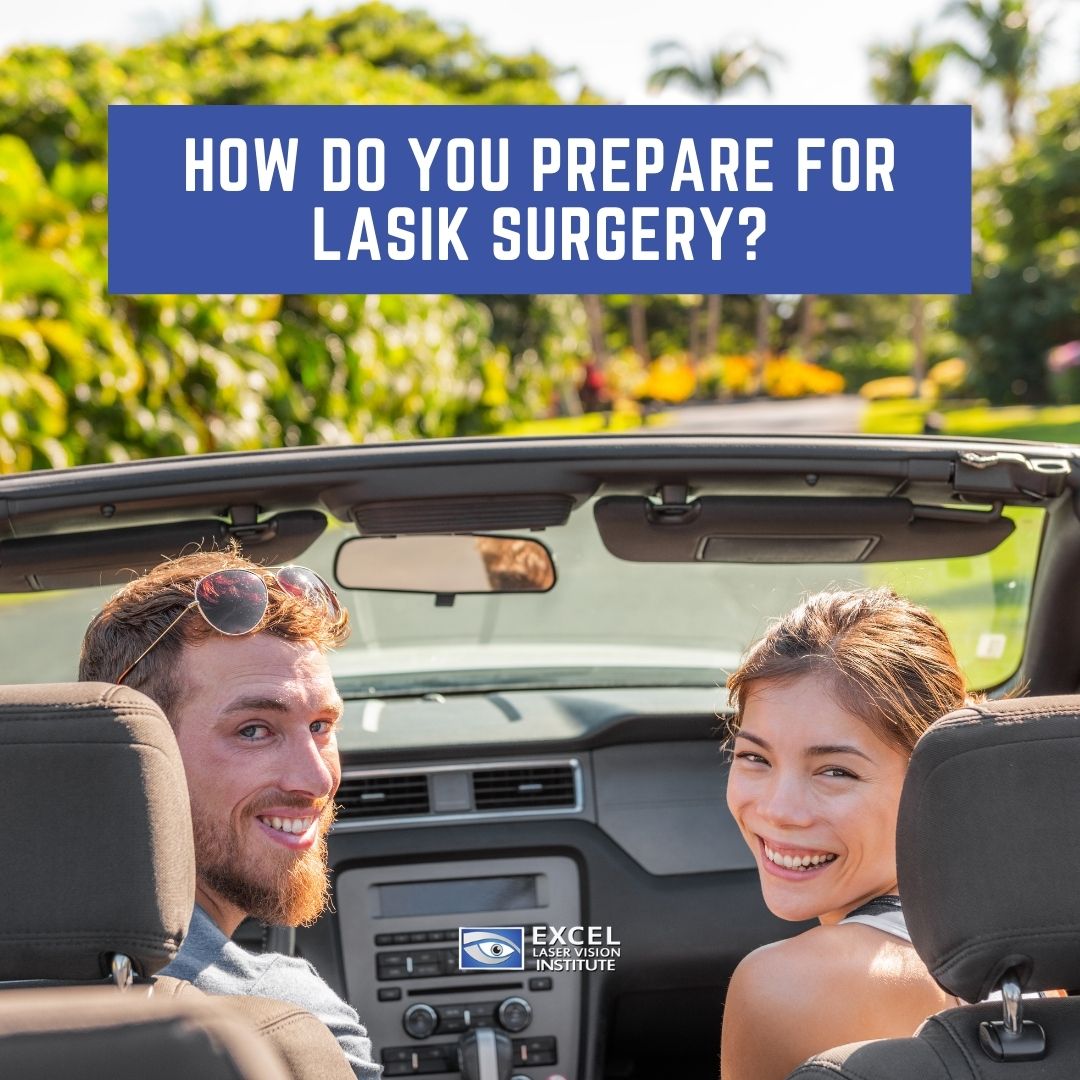
How Do You Prepare For LASIK Surgery?
The most challenging step that you will take before having LASIK in Los Angeles is finding the appropriate clinic with the most sophisticated technology and the best Lasik eye surgery. This is the most crucial aspect that ascertains the quality of the surgery you are going to undergo.
Also, it really helps to establish how smooth your recovery will go and guarantees you achieve optimal vision from laser vision correction.
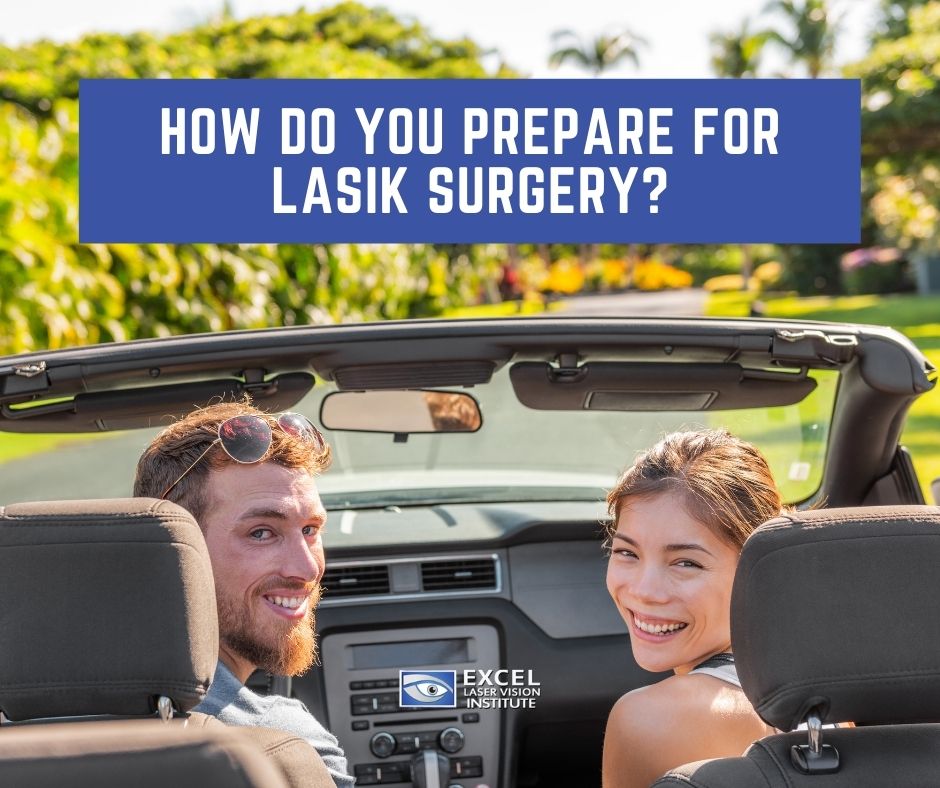
When you have chosen LASIK for your corrective eye surgery, your eye doctor has conducted a baseline evaluation to find out if you are a good candidate for the procedure, then you can prepare for the surgery.
Doctor Moosa, the eye surgeon at Excel Laser Vision Institute, believes that if a patient prepares well for surgery, there is a higher probability they will be in a better condition for the procedure.
The LASIK clinic has several years of experience preparing patients for LASIK surgery under their belts, and they have some tips below to help you prepare for the procedure.
Take a look at the best way to be ready for LASIK surgery here:
Drink Plenty Of Water Before The Procedure
This tip is true for any procedure you go through. It is crucial that you drink more water unless your doctor tells you not to. When you undergo a LASIK procedure, you are doing more good than harm by stepping up your water intake. Increasing your water intake will help you to maintain hydration and encourage the healing process after your procedure.
The most common side effect of LASIK eye surgery is temporary dry eye. Drinking more water is an easy way to keep your eyes lubricated.
If you have already booked your LASIK procedure, do not want any longer to start increasing your water intake. You want to set a target of at least 8 eight-ounce glasses of water per day. It sounds like a massive of water to consume, but it is the basic minimum you should be drinking to maintain sufficient hydration.
If you are determined to drink more water but you are apprehensive about keeping track, there are apps available to help you oversee your water intake, let you know when it is time to fill up your glass, or help to calculate your body’s optimal water intake.
If you have any questions or concerns regarding your water intake before your LASIK procedure, do not hesitate to talk to Dr. Ferzaad Moosa and his experienced team.
Stop Wearing Contact Lenses When Instructed To
Before your LASIK procedure, your eye surgeon will advise you to stop contact lens use for at least one week for soft contacts and one month for hard contacts. The reason for discontinuing contacts prior to LASIK surgery is because wearing contacts can change the shape of your cornea and affect the results of your LASIK procedure.
Also, it is a good idea to give your eyes a rest, i.e., switch to eyeglasses for a while before your surgery.
When to stop wearing contacts is a significant conversation that you should have with your eye doctor. Your eye doctor will recommend how long before your procedure you should stop using contact lens based on your eye evaluation.
Get A Comfortable Outfit Prepared
Your outfit on the day of your LASIK surgery matters a lot. You will be awake during the LASIK procedure, so it is essential to be wearing comfortable clothing. Choose loose clothes that you can easily take off when you get back home.
Comfortable clothing such as leggings, athletic shorts, a zipper hoodie, or a soft t-shirt is suitable. When you receive LASIK, the first thing you want to do when you arrive home is sleep. It is simpler to rest at home when you are wearing clothes that you can rest in or easily get out of.
Plus, try not to wear clothes that produce lint. So, avoid clothing items such as faux fur or anything that could be shed. This is important because you keep contaminants out of the operating room. LASIK is a safe and sterile procedure, so make the extra effort to avoid bringing unnecessary contaminants.
Designate A Driver
During LASIK, the patient is not put to sleep. Instead of this, numbing eye drops are put in the eyes. If you are nervous about the procedure, you may get medication to help you relax.
The purpose of numbing eye drops is to make certain you don’t feel any pain when undergoing LASIK. These drops wear off after a few hours once the procedure is over.
Even though the patient is not put under during LASIK, you are not allowed to drive yourself home afterward. You should have a family member or friend drive you to the procedure and back home again.
Most LASIK patients are told by their eye doctors that they are good to drive during their follow-up appointment the next day. When you get cleared by your eye doctor, then you can safely be back behind the wheel.
Go Through Your Paperwork
The team at Excel Institute will give you a LASIK consent form before you go for your procedure. You should read your paperwork thoroughly, and ask any questions you have regarding your LASIK procedure. You should have peace of mind that you are making an informed decision about the procedure ahead.
On The Big Day, Do Not Wear Any Perfume, Lotions, Or Makeup
On the day of your LASIK procedure, do not apply heavy makeup, perfumes, or lotions. If possible, go as bare as you can. You should take a shower and make sure your face is clean of any contaminants the morning of the LASIK. Do not apply any perfumes or hand or face lotions either since this can make your skin greasy. It is best to go to your LASIK procedure clean and prepared, and usually, greasy lotions tend to get into the eyes. It is always a good idea to play it safe before you have your LASIK surgery.

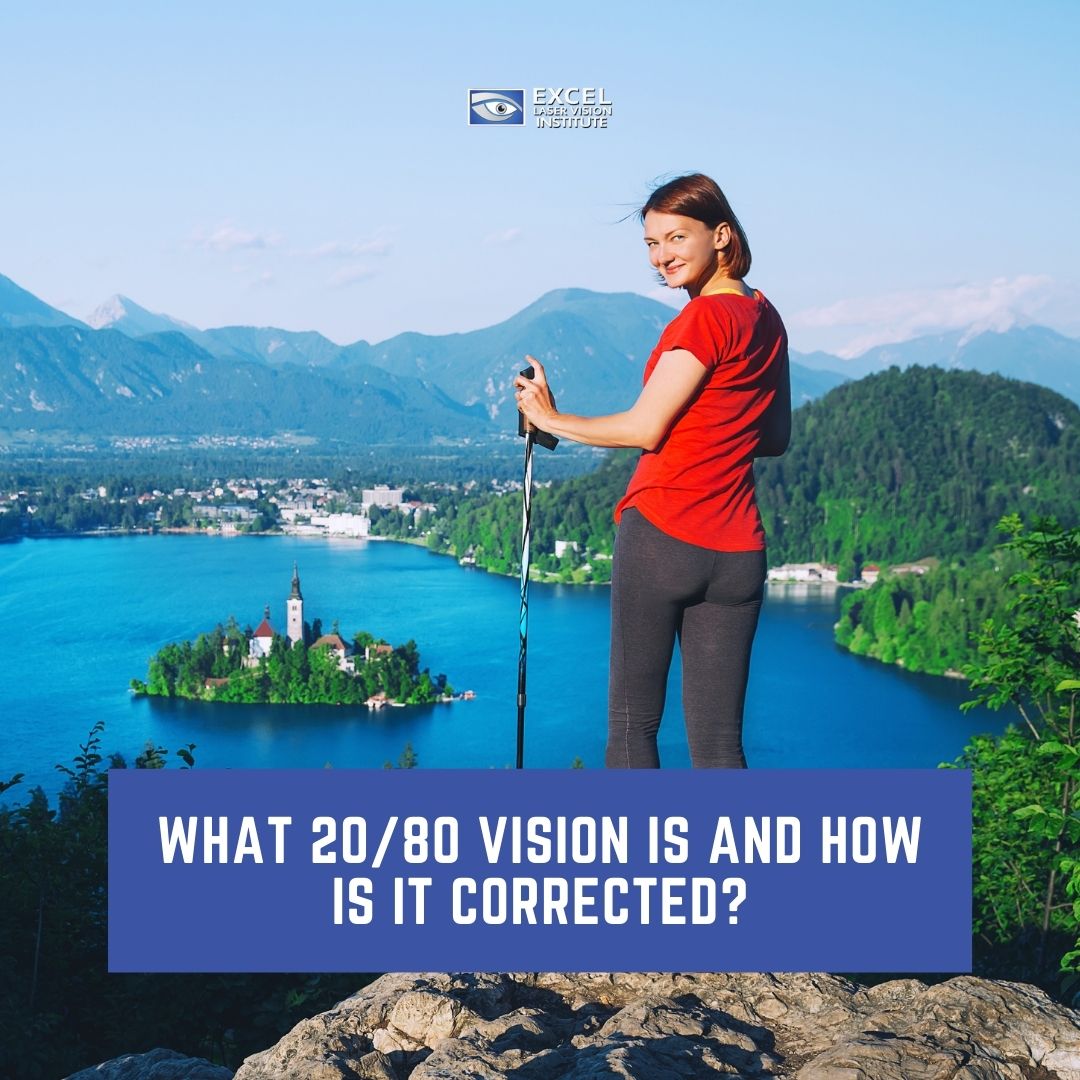
What 20/80 Vision Is And How Is It Corrected?
When patients think about visual acuity, it isn’t a shocker to learn that they believe that 20/20 vision is the gauge of good eyesight. We all, at some point in our lives, have tried to reach this goal. Remember when your parents told you you had to eat all your carrots, get enough sleep, don’t sit too close to the T.V., and don’t read in low lights to avoid straining your eyes? Yup, most of us got the same advice, and a good majority of us are still as blind as bats.
Fill out the form for a Free Evaluation
In any case, when you visit a laser eye surgery clinic in Los Angeles, you will be told that the biggest determinant in declining vision is sometimes something you can’t even avoid. That is because we all have birthdays. Aging is the biggest reason why visual acuity alters, besides eye diseases and poor nutrition – even if you eat more carrots than Bugs Bunny himself!
What is 20/80 Vision?
Doctor Moosa of Excel Laser Vision Institute, a LASIK eye center in Los Angeles, explains that when a person has 20/80 vision, the individual‘s eyesight is already in the low vision range. 20/80 is an average visual impairment as regulated by the International Council of Ophthalmology (ICO). Sometimes LASIK doctors in Los Angeles may declare that your visual acuity is 0.25, essentially the same as 20/80. It is just labeled in its decimal notation, or you can put it in terms of 4.0 for visual angle.
Therefore, what does this all refer to? The LASIK Los Angeles clinic uses the interpretation of the ICO as a visual impairment that is still more functional than someone with a 20/200 vision, who is in a severe visual impairment range.
If a person has this condition, low vision is apparent but not to a point where the patient would be considered legally blind. If you take a look at the average size of common newsprint, which measures at 1 M. If you don’t know what 1 M is, the Sloan M system is used to measure letter size in a reading chart. Louis Sloane first introduced this to the American Journal of Ophthalmology in 1959 and has been utilized as the standard by the Committee on Vision of the U.S. National Research Council ever since it was first popularized.
This is what is used during visual acuity tests. The M-unit is linked to a fixed 1-meter distance when one of the letters in Sloane’s reference standard spans a visual angle of 5 min of arc, which is a unit angular measurement. Therefore, research lets us know that 1 M is the same as the average newsprint size, as declared in most published research.
Of course, when visual acuity becomes weaker, a person reads better at a shorter distance, usually with reading glasses. Normally, newsprint is read clearly at a distance of 40 cm. However, if you are one of the lucky ones with 20/20 vision, you can read 1 M at 100 cm, so reading the small print isn’t a challenge for these guys.
However, if the patient has 20/80 vision, 1 M is read at 25 cm, so patients have to use strong lenses to read clearly, or in the case of nearsightedness, they have to hold the paper nearer to the eyes than someone with 20/20 vision.
What Causes Visual Acuity To Change To 20/80?
As we age, visual acuity worsens. You may not require eyeglasses or contact lenses just yet, but at some point, your ophthalmologist will advise you to start wearing them. When you get to your sixties, the probability of having advanced presbyopia increases, and the appearance of floaters. Also, when women reach their menopausal stage, they are more prone to dry eyes, resulting in visual acuity issues.
Age-related determinants that can affect visual acuity and lead to low vision, according to the American Optometric Association (AOA), include:
- Smaller pupil size.
- Absence of peripheral vision.
- Macular degeneration.
- Glaucoma.
- Traumatic brain injury.
- Detachment of the retina.
Can You Correct 20/80 Vision?
You can correct your vision. For example, your doctor may recommend eyeglasses or contact lenses. However, if you are searching for a long-term solution, it may be corrective surgery.
Advanced methods of eye treatment technology can produce results near 20/20 vision. Sometimes light adjustable lenses and other advanced intraocular lenses are used to treat cataracts so patients can receive improved vision.
Still, a well-known procedure known as LASIK can help you achieve a patient’s goal of 20/20 vision or even better when possible. If you are a good candidate for this procedure, then your likelihood for improvement can be based on pre-operative testing. LASIK is an effective way to see clearly without the need for eyeglasses or contact lenses.
The alternatives to LASIK are PRK, ICL, RLE, and refractive cataract surgery. These are some of the procedures that eye doctors recommend to patients depending on their condition.
Ultimately LASIK is performed to help correct a patient’s vision to a level that keeps them comfortable and highly satisfied.
Where to get LASIK in Orange County or Los Angeles
You should never put your eyes in danger because they are very important to you. Make sure you go to an eye clinic that can make you feel comfortable throughout the whole process.
Yes, indeed, LASIK can be expensive, but that doesn’t mean that it’s not a smart personal investment. At Excel Laser Vision Institute, we are aware that paying out-of-pocket is something that most patients are prepared to do, so we have made it simpler for our patients to achieve better vision. We have several financing options that you can avail yourself of for better eyesight.

Choosing a LASIK Provider
When considering LASIK surgery, it’s crucial to choose a reputable provider for safe and effective treatment. Excel Laser Vision Institute, led by Dr. Ferzaad Moosa, offers comprehensive LASIK services in Orange County and Los Angeles. With over 23 years of experience, including specialized training at Harvard Medical School, Dr. Moosa is one of the most experienced LASIK surgeons, specializing in all laser LASIK, SMILE, PRK, Contoura-Topo guided LASIK, and wavefront-optimized all laser LASIK.
1. Board Certification: Dr. Moosa is board-certified and has undergone specialized training in refractive surgery, demonstrating his expertise in the field.
2. State-of-the-Art Technology: Excel Laser Vision Institute utilizes the most advanced technology, including the Wavelight EX500 laser and the VisuMax, to ensure precise and accurate results for LASIK patients.
3. Patient Reviews and Testimonials: Dr. Moosa and his team have received glowing reviews and testimonials from previous patients, highlighting their exceptional care and successful outcomes.
4. Consultation Process: Excel Laser Vision Institute offers a comprehensive consultation process, where Dr. Moosa evaluates your candidacy for LASIK surgery and addresses any questions or concerns you may have.
5. Follow-up Care: Dr. Moosa and his team provide personalized follow-up care to monitor your progress after LASIK surgery, ensuring optimal results and satisfaction.
6. Cost and Financing Options: Excel Laser Vision Institute offers competitive pricing for LASIK surgery and provides financing options to make the procedure more accessible for patients.
By choosing Excel Laser Vision Institute and Dr. Ferzaad Moosa for your LASIK surgery, you can rest assured that you are receiving top-quality care from a trusted and experienced LASIK provider. Contact Excel Laser Vision Institute today at (888) 957-3255. Or else, visit our website to learn more: https://www.exceleye.com/.
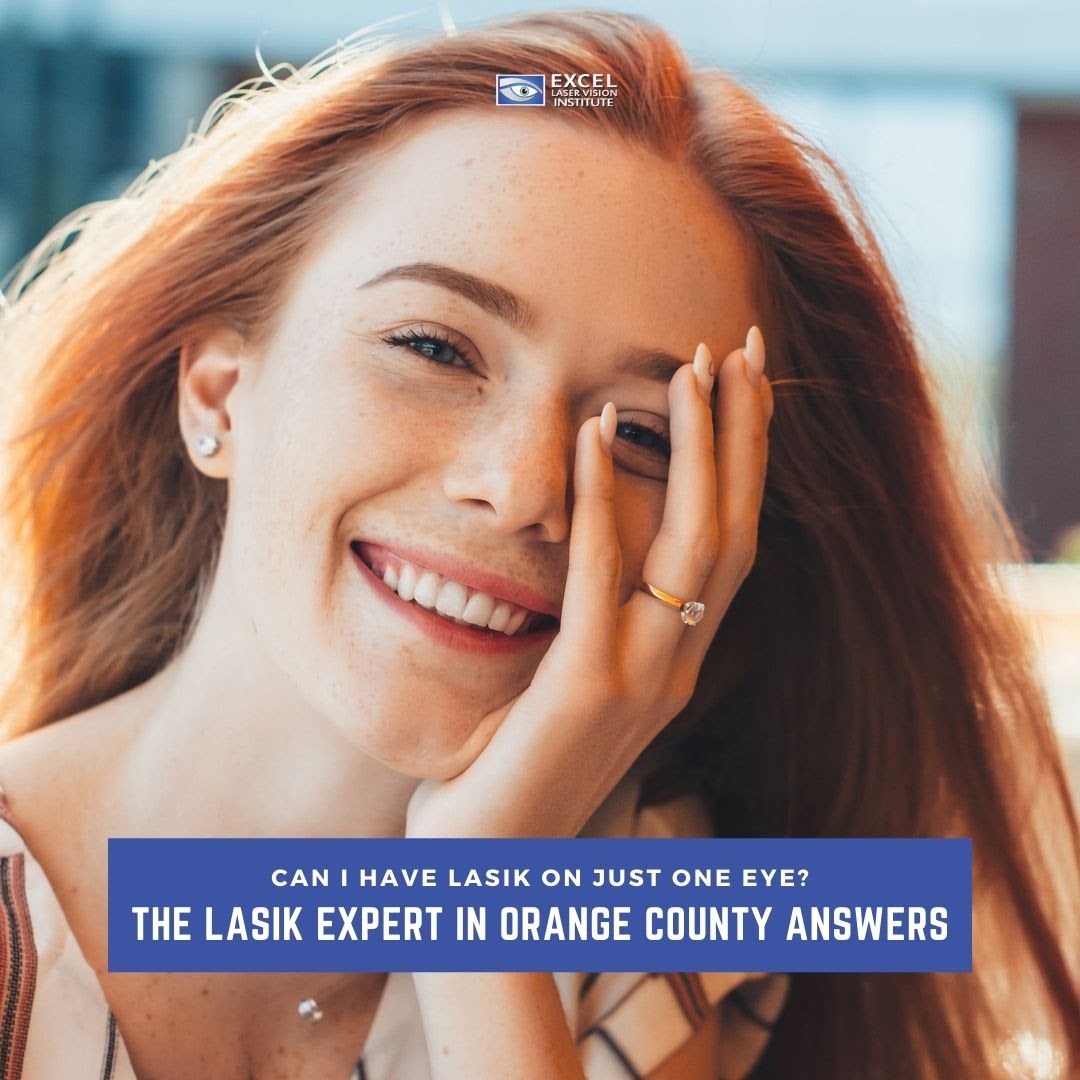
Can I Have LASIK On Just One Eye? The LASIK Expert In Orange County Answers
Many patients can’t wait to get to LASIK in Orange County because having laser eye surgery is a remarkable and exciting experience. With the best laser eye surgery at Excel Laser Vision Institute, you can guarantee that you will be able to see more clearly after the procedure.
Although many patients of LASIK eye surgery in Orange County experience a huge improvement in their eyes after LASIK surgery, some of the things are not as simple as it seems. The fact of the matter is that some patients are often concerned whether it is safe or not to get LASIK in both eyes simultaneously or if they should have the procedure carried out on one eye only at first then get back to the other eye at a later date.
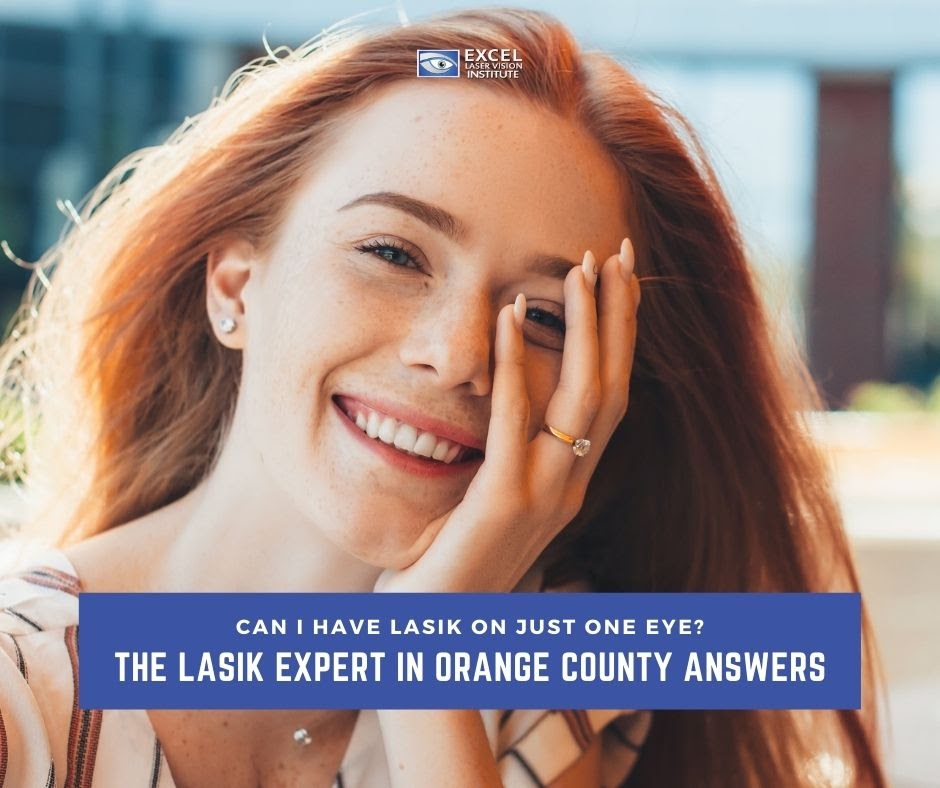
How Do Eyes Work?
To get clear vision thru LASIK in your eyes, you need to get the cornea and lens to refract or bend light rays to focus them on the retina in the back of the eye. The retina sends the light rays to the brain in the form of impulses for the brain to understand them as being images. When the light rays are not focusing on the retina, it causes blurry vision or refractive error. The purpose of LASIK is to correct this inaccuracy to provide a better vision.
If you have any part of the eye that is not perfectly shaped, such as the cornea, lens, or eyeball, it can cause refractive errors and make your vision blurry. As a result, there is a difference between the curvature of the cornea and the length of the eye. This can happen in one eye, while the other eye has a near-perfect vision, or it can occur in both eyes in different ways.
Why Would You Get LASIK In One Eye?
In some instances, LASIK is performed on both eyes simultaneously. Nevertheless, there are a few cases in which LASIK is required for only one eye or patient requests that each eye gets treatment on different days.
Here are the two most common reasons patients receive LASIK only on one eye.
Visual Disorders Affecting Only One Eye
The main reason for LASIK being carried out on only one eye is refractive errors, specifically anisometropia (lazy eye). Refractive errors can be a result of several conditions in an eye that LASIK procedures can correct. For instance, you may be nearsighted, farsighted, and experience astigmatism in only one eye. Another visual disorder is Presbyopia. This is an age-related eye condition that affects a person’s ability to see because of seeing up-close, and their vision is blurred.
Patient’s Request
Sometimes a patient may want to have LASIK performed on one eye at a time, usually choosing the “bad eye” first. The reason for this is because they would like to see whether the benefits of LASIK are worth it before getting the other eye treated. Some believe that this is a safe method.
What Is Monovision LASIK?
Monovision LASIK refers to having LASIK surgery to give the patient good near vision in one eye and good distance in the other. Normally, the dominant eye is first determined, and then the patient is first given contact lenses with distance vision in the dominant and near in the non-dominant.
If the patent states that he or she is satisfied with the vision they achieved during this “experiment”, only then are they offered LASIK to get the same result.
If a patient already has good vision in both eyes, the contact lens trial is carried out by just wearing a near contact lens in the non-dominant eye. If all goes well, the patient would then proceed with LASIK for nearsightedness in one eye.
Should I Have LASIK On One Eye Only?
At Excel Laser Vision Institute, a LASIK clinic in Orange County, some patients want to make sure they have a good result in one eye before going forward with the other eye. Patients sometimes believe that it is somehow safer to do one eye at a time, which, judging from the surface, does feel like a more conservative and careful approach.
But here is the issue with thinking in that way:
According to a LASIK surgeon in Orange County, there is no real proof that you will experience fewer complications if the eyes are treated separately. Plus, when you consider the inconvenience factor to the whole situation, such as doubling the number of consultation visits and follow-up appointments, it isn’t difficult to figure out why people usually opt to treat both eyes simultaneously.
Is Getting LASIK In One Eye Necessary?
As you can probably tell right now, there is no general right or wrong answer to this question. If an eye surgeon believes that a patient is a good candidate for LASIK in both eyes, there is usually nothing holding them back from getting both eyes done simultaneously.
If you are concerned about having LASIK in both eyes or you only need LASIK in one eye, then obviously, just get the LASIK performed in that single eye to ensure you get the best treatment for your unique situation.
Contact Excel Laser Vision Institute at (888) 957-3255 so you can talk to an eye care professional. Excel Laser Vision Institute is a reputable LASIK clinic in Orange County. Laser eye surgery can treat many refractive errors and ensure that your vision is excellent. LASIK professionals will thoroughly evaluate your eye health and condition before establishing if you are eligible for LASIK eye surgery or a similar procedure.
Dr. Moosa is a well-known LASIK surgeon with a Harvard education and a wealth of experience working with different prescription levels. Dr. Moosa has helped many professionals achieve their vision goals, from athletes to models to military personnel. Visit our website to learn more: https://www.exceleye.com/.
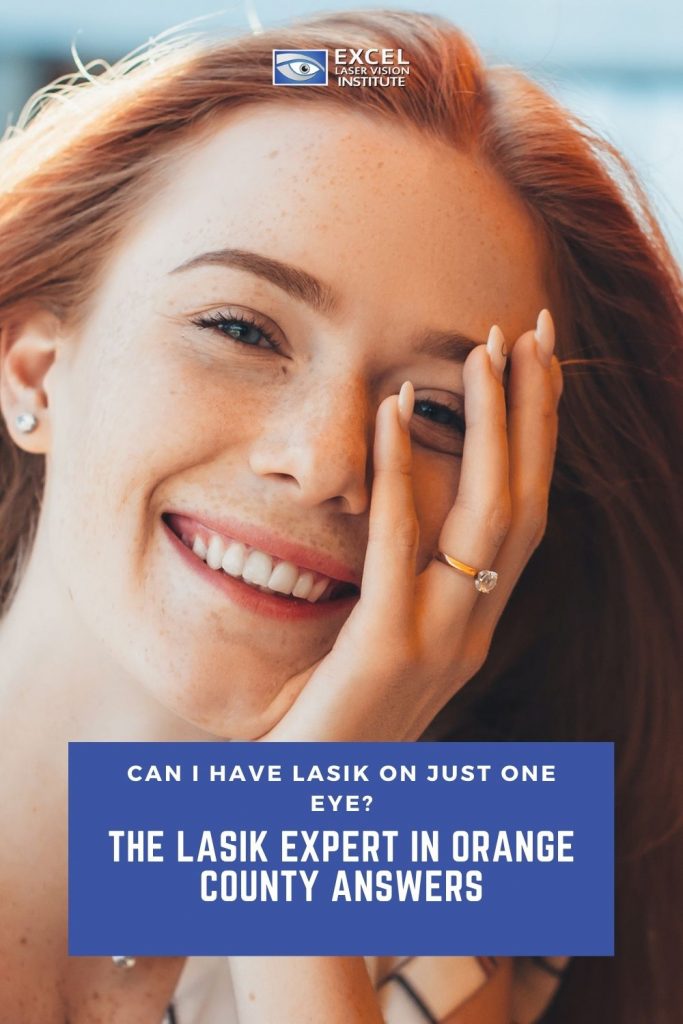

Can LASIK Help Me Cope With My Migraines?
When LASIK patients in Los Angeles ask, “can LASIK cure my migraines?” The short and sweet answer is, no. Unfortunately, LASIK is not a cure for migraines. However, if you think long and hard about it, neither can a bandage heal a wound. In order for our bodies to heal, we can only improve the settings and leave a huge amount of detailed work to biochemistry. Therefore, if you were to ask the best LASIK surgeons in Los Angeles whether LASIK can help cure migraines, the answer is a slightly more complicated answer rather than a simple “no.”

Ocular And Visual Migraines: What Are The Prevention And Treatment Options
When an ocular migraine happens, it can be very shocking since the symptoms usually cause temporary blindness. Although ocular migraines are rare when a migraine does happen it can have a very debilitating effect. If you have a medical history of migraines or you are experiencing this condition for the first time, it is best to talk to your LASIK eye doctor in Los Angeles to find suitable treatment options for you.
What Are Ocular Migraines?
An ocular migraine refers to a wide range of migraine subtypes that cause visual disturbances. Other forms of migraines are distinguished by severe headaches and other symptoms. However, ocular migraines are unique because temporary vision issues can happen without pain or headache.
What Are The Symptoms Of Ocular Migraines?
The LASIK surgeons in Los Angeles inform us that the symptoms of ocular migraines are different from person to person, but an individual can have varying symptoms for each migraine. The most common symptoms that ocular migraines bring are the following:
- Temporary vision loss
- Temporary blindness (usually in one eye)
- Blindspot (usually in one eye, affecting central vision)
- Headache
The word “migraine” is usually linked with a very bad headache. Although a headache is part of the experience of having an ocular migraine, there are many instances when patients experience vision problems without the pain of a headache.
The Difference Between Visual Migraines And Ocular Migraines
Sometimes patients at LASIK Los Angeles clinics mistakenly use the words “visual migraines and “ocular migraine” interchangeably. Although the reality is they are both two separate conditions. Another word that is usually used for a migraine that causes visual disturbances is an “optical migraine.”
And though some of the symptoms are similar, there are a couple of unique symptoms that happen with a visual migraine, which is sometimes known as an aural migraine:
- Wavy ring of light
- Zig-zagging light
- Flickering blind spot
- Visual migraine aura
- A blind spot that moves in the field of vision
In the beginning, an ocular migraine starts off as something small. However, over time the spot becomes larger and causes more disruptions to a person’s ability to see.
In some instances, ocular migraine symptoms have a duration of 30 minutes or less. Nevertheless, there are times when symptoms stick around for an hour before a person’s vision returns completely.
Another massive difference between ocular migraines and visual migraines is how the eyes are affected. If you are experiencing an ocular migraine, then it usually affects only one eye. On the flip side, both eyes are usually affected when a person has a visual migraine.
What Causes Them?
For the most part, the cause of regular migraines and ocular migraines are very much alike. Research has confirmed that changes happen in the blood flow in the eye when the migraine is occurring. These alterations may be the cause of a reduction in blood flow or a blood vessel spasm, which affects the retina that is in the back of the eye.
Although these changes in blood flow have been recognized through imaging studies, researchers are still hesitant about the exact cause of the reaction. It shows that an outside trigger activates an area within the brain that releases inflammatory substances. This inflammatory response is what affects the nerves and blood vessels in the brain as well as the head.
Apart from your overall blood flow, genetics makes a huge difference in a person’s risk of being susceptible to them. Studies have shown that those who suffer from ocular migraines usually have a close relative who also experiences migraine headaches.
Furthermore, it is not unusual for a trigger to bring about each episode. These triggers are different from person to person. Therefore, it is recommended to track your migraine patterns to see if you can spot environmental factors that happen before the migraine began.
The most common triggers include stress, glaring lights, flickering lights, lack of sleep, strong odors (cigarette smoke or strong perfume), or consuming specific ingredients (MSG, caffeine, chocolate, red wine, aged cheese, or artificial sweeteners).
What Can LASIK Do For Migraines?
Since blood flow and visual strain are the most common factor for migraines, it makes sense to relieve visual strain to cure migraines. However, if migraines are not at all related to visual strain, then LASIK may not have any effect. So, although LASIK cannot cure migraines, it can certainly cure eye strain, and that helps a person who suffers from consistent migraines to give them a bit of relief.
When Should You See Your Eye Doctor?
Whenever you experience vision loss, it is highly advisable to consult with an eye doctor. Although the symptoms of an ocular migraine are temporary, you should find some medical help to look out for signs of other eye conditions that could lead to permanent vision loss.
It is a good idea to quickly have an eye exam to find any signs of a more serious condition. As a matter of fact, the symptoms of an ocular migraine are very similar to those of retinal detachment. If you are experiencing retinal detachment rather than an ocular migraine, immediate treatment is required to reduce the risk of permanent vision loss.
Contact Excel Laser Vision Institute at (888) 957-3255. Our team of staff is highly skilled and experienced. In the office, we also have Dr. Moosa, a well-esteemed LASIK surgeon that has a Harvard education and a wealth of experience working with different prescription levels. Visit our website to learn more: https://www.exceleye.com/

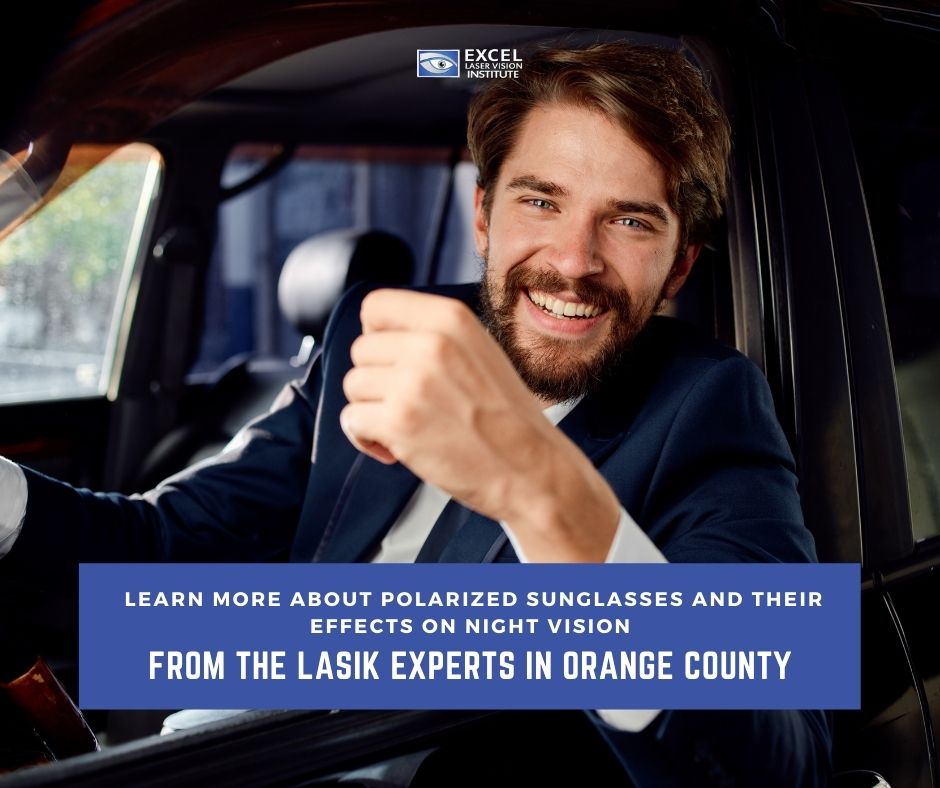
Learn More About Polarized Sunglasses And Their Effects On Night Vision
You may have heard of polarized sunglasses from some of your friends or family. If you have trouble seeing where you are going as you drive about at night, you are probably looking for options to improve your sight while you cruise down dark roads.
Indeed, Doctor Moosa, a well-known LASIK surgeon in Orange County, believes that polarized sunglasses are a good way of reducing glare in bright situations such as boating, outdoor sports, or even driving on a sunny day. However, what about instances when you want to lessen the distracting reflection of headlights and street lights at night?

What Are Polarized Lenses?
Doctor Ferzaad Moosa, a LASIK expert in Orange County, gently explains that a “polarized lens” has a laminated filter applied to the lens to prevent a portion of light from passing through the eye. The whole point of wearing polarized sunglasses is to use them for settings where the light is more intense when reflected off flat surfaces, which increases the amount of light and makes it challenging to see clearly.
LASIK eye doctors tell us that light is important for the eye to see, but when more light enters your eye, it knows what to do with it; it causes glare. In layman’s terms, glare occurs when your eyes are exposed to a lot of bright light.
Also, you have to consider that only allowing a limited amount of light into the eye allows polarized lenses to reduce glare, leading to improving vision.
The LASIK experts, particularly Doctor Moosa of excel laser Vision Institute in Orange County, say that the truth about polarized lenses is that they can help to reduce the glare of oncoming traffic lights when driving after dark. Nevertheless, wearing sunglasses of any type in low-light conditions, particularly while driving, is dangerous and absolutely not advised.
Can Polarized Lenses Help With Night Driving?
Even though polarized lenses could lessen glare from oncoming traffic, they don’t automatically assist with night driving and could, perhaps, do more harm than good.
The filter on polarized lenses blocks some light from hitting the eye, so it creates a dimmer view when you wear them. Preventing extra light from an already low-light condition can limit your vision even further compared to the glare of traffic lights.
If you notice that driving at night is becoming a burden, there are other options to wearing polarized sunglasses to get clear vision when driving, especially at night.
What Are Night Vision Glasses?
Night-driving glasses are the go-to choice for people who want additional contrast and clarity on the road, but the effectiveness of this eyewear isn’t as good as expected.
In 2019, the Schepens Eye Research Institute conducted a study to determine how useful night driving glasses really are.
The researchers brought together 22 adults who portrayed a huge population and had them drive in four nighttime driving simulations.
The simulations put the drivers in many different experiences, including a machine that copied the effect of oncoming traffic lights while wearing either clear lenses or yellow-tinted night driving glasses.
The participants in this research study had their reaction times recorded in each scenario every time they saw a pedestrian on the roadway side.
The study’s conclusive results were that wearing night driving glasses made no improvement in driver performance in the most critical task, and that is detecting pedestrians.
Besides that, researchers claim that a slight amount of statistical data revealed a marginal decline in performance when wearing night vision glasses compared to driving without them.
Generally speaking, the results of the study above do not back up the concept that eye care professionals should prescribe night-driving glasses to patients.
What Are The Best Night Vision Glasses For Driving?
If you experience some challenges when driving at night which are affecting how frequent or when you drive, you should take some time to get an eye exam and talk about your issues with an eye doctor. They can prescribe lenses with anti-reflective coating to reduce the glare you experience when driving.
If it turns out that you don’t need a prescription, your eye doctor can recommend non-prescription lenses that can be bought with the same coating to reduce the irritating reflections of headlights and streetlights.
Why Night Vision Glasses May Be A Bad Idea
Normally, glasses with yellow-tinted lenses can improve contrast in specific daylight conditions because the yellow tint prevents some of the sun’s blue light from entering the eye.
This high-energy visible (HEV) blue light is probably the cause of glare when it comes into contact with the eye, compared to other forms of visible light.
Yellow tinted lenses give off a blue-blocking filtration which usually happens with amber and copper-colored lenses.
These darker tinted lenses can prevent a lot more blue light from entering than yellow lenses. However, they also block more light from entering the eye, which lowers visibility even more in low-light conditions.
As a matter of fact, yellow lenses lower the overall visible light to a certain level because they also block some blue light. Perhaps this is beneficial during the day, but not at night when you have to see as much as possible.
It is a shame that some people feel that they have to give up driving at night or low-light glare.
However, if you are really serious about improving your eye vision, then speak to an eye care professional at Excel Laser Vision Institute, a reputable LASIK clinic in Orange County. Laser eye surgery can treat many refractive errors and ensure that your vision is in tip-top shape before you drive on busy and dangerous roads at night. LASIK professionals will conduct a thorough evaluation of your eye health and condition before determining if you are eligible for LASIK eye surgery or a comparable procedure.
Call Excel Laser Vision Institute at (888) 957-3255. Our team of staff is highly trained and knowledgeable. In the office, we also have Dr. Moosa, a well-esteemed LASIK surgeon in Orange County with a Harvard education and a wealth of experience working with different prescription levels. Dr. Moosa has helped many professionals achieve their vision goals, from athletes to models to military personnel. Visit our website to learn more: https://www.exceleye.com/

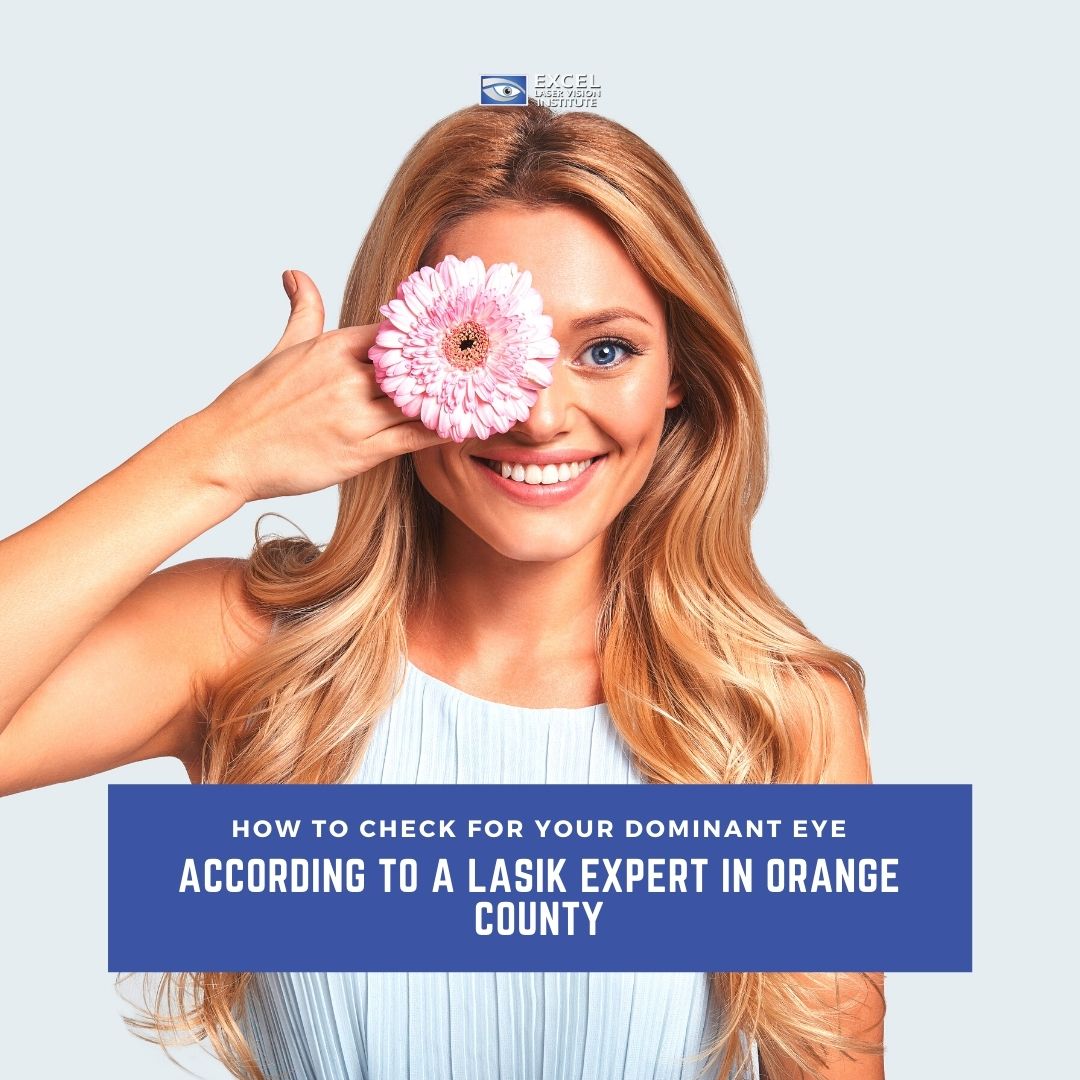
How To Check For Your Dominant Eye According To A LASIK Expert in Orange County
You have probably heard the term dominant eye and ocular dominance before whether from a LASIK expert in Orange County, on the internet, in books and magazines, or elsewhere. However, some laser eye surgery patients aren’t too sure about what they mean or how you perform a dominant eye test? Here are few elementary things you should know:
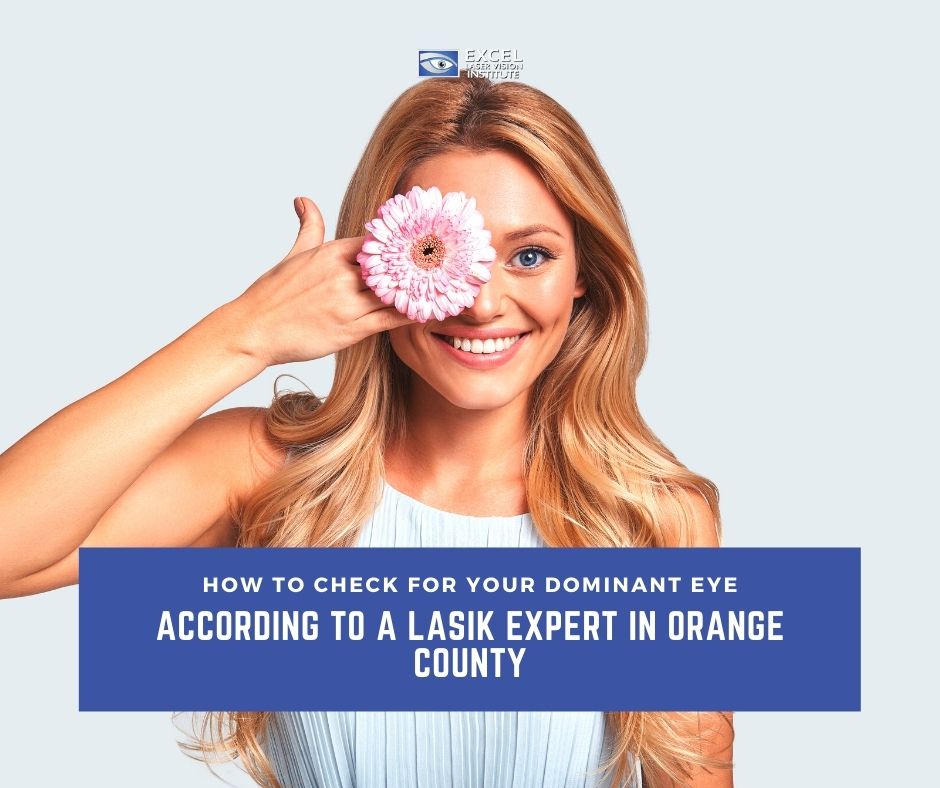
What Is A Dominant Eye?
In a nutshell, a dominant eye is an eye that gives you a slightly greater extent of input to the visual part of the brain and more precisely relays information about the location of objects. Normally, the term “dominant eye” is used when explaining the normal visual condition where two eyes work well as a team and have equal visual acuity. One eye is just the leading or preferred eye.
Nevertheless, there are times that the term dominant eye is used to describe the normally sighted ad functioning eye in dysfunctional cases such as amblyopia and strabismus.
Dominant Eye Test
You can do this simple dominant eye test at home to find out which eye is your preferred eye:
- Bring your arms out in front of you and create a triangular opening between your thumbs and forefingers by placing your hands together at a 45-degree angle.
- With both eyes open, center this triangular opening on a distant object — such as a wall clock or doorknob.
- Close your left eye.
- If the object stays centered, your right eye (the one that’s open) is your dominant eye. If the object is no longer framed by your hands, your left eye is your dominant eye.
You can also do this easy dominant eye test:
- Extend one arm out, holding the thumb of that hand in an upright position. (Or you could use your index finger instead of your thumb.)
- Keeping both eyes open and focused on a distant object, superimpose your thumb on that object. (Don’t worry if it looks like your thumb partially disappears — that’s normal.)
- Alternately close one eye at a time.
- The eye that keeps your thumb directly in front of the object while the other eye is closed is your dominant eye.
Both of these dominant eye tests are classified as “sighting” tests because they entail aligning a visual target with a makeshift sighting device. Essentially, this copy cats the “sight” on the barrel of a rifle).
Some studies have revealed that sighting dominant eye tests, even though they are easy to perform and are usually accurate, can be influenced by handedness and other non-visual factors.
To prevent these confusing aspects, some researchers bicker about the fact that non-sighting dominant eye tests could be a more precise method to find out a person’s dominant eye, which is also referred to as ocular dominance.
During these tests, the person has to keep both eyes open, and visual stimuli are shown to each eye separately just using special optical devices. So, this is the limitation of non-sighting dominant eye tests, the equipment, and expertise of a LASIK surgeon in Orange County needed to perform them are usually only located in specialized vision clinics such as the LASIK clinic, or research facilities. In many instances, straightforward sighting eye tests such as the ones described above will precisely reveal an individual’s dominant eye.
Eye Dominance And Handedness
The LASIK doctors in Orange County make it very clear that eye dominance and handedness ( whether you are right or left-handed) are not directly associated, these characteristics are greatly linked.
Studies conducted on a large mass of people reveal that around 90% of subjects are right-handed and about 67% are right-eye dominant.
Furthermore, research has shown that the probabilities of a person who is right-handed being right-eye dominant are high with about 2.5 times more probability than the odds of that person being left-eye dominant. So, it is unlikely you can predict eye dominance just on handedness alone.
Is It Possible Not To Have A Dominant Eye?
Is it likely that a person does not have a dominant eye? Yes, it is possible but very uncommon.
If there isn’t a strong level of dominance in a dominant eye test, it’s more likely the individual has mixed ocular dominance, which is sometimes known as ocular dominance. In a situation like this, one eye is dominant for specific functions or tasks, and the other eye is dominant at varying times.
Some people may do a sighting dominant eye test and realize that the visual target is not accurately aligned with the triangular opening between their hands with their thumb with either eye.
Sometimes eye dominance falls on a spectrum among certain individuals, and the same goes for handedness. Therefore, some people could have one eye that is very dominant, while others may have less of a difference in the dominance of two eyes.
To some extent, most of the time eye dominance is inbred in your brain.
The visual cortex, which is the part of the brain that processes visual information, are strips of nerve cells (neurons) known as dominant eye columns. These bands of neurons appear to respond alternatively to input from one eye or the other and are important to the development of binocular vision, varying and sometimes being incomplete in some people.
If you are a shooter, photographer, or athlete and would like to level up your performance, then speak to a LASIK professional at Excel Laser Vision Institute, a reputable LASIK clinic in Orange County. Laser eye surgery can treat many refractive errors and ensure that your vision is in tip-top shape before your next sporting event, hunting season, or the photo session you have lined up. LASIK professionals will conduct a thorough evaluation of your eye health and condition before determining if you are eligible for LASIK eye surgery or a comparable procedure.
Call Excel Laser Vision Institute at (888) 957-3255. Our team of staff is highly trained and knowledgeable. In our Orange County clinic, we also have Dr. Moosa, a well-esteemed LASIK surgeon that has a Harvard education and a wealth of experience working with different prescription levels. Dr. Moosa has helped many professionals achieve their vision goals, from athletes to models to military personnel. Visit our website to learn more: https://www.exceleye.com/.
